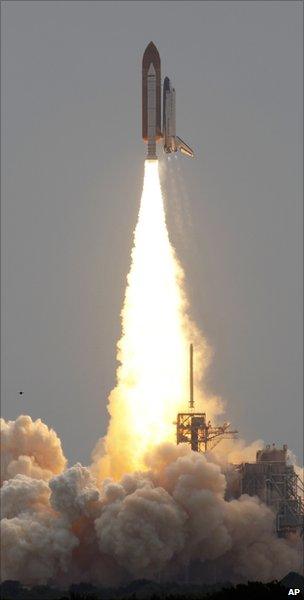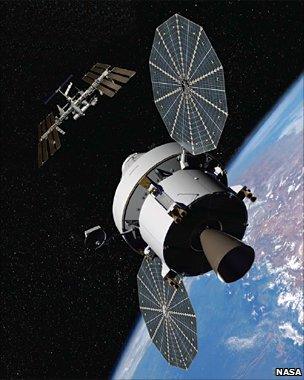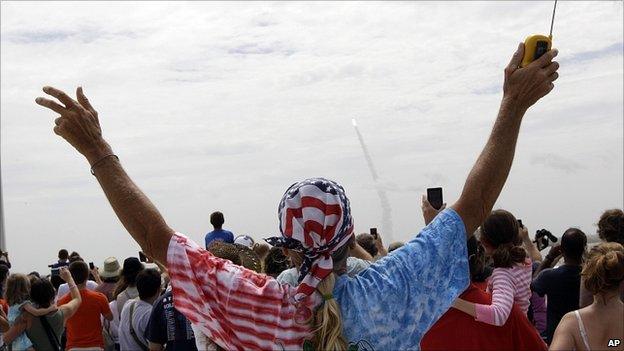Nasa argues for 'incredible future'
- Published
- comments

One last time: The Atlantis shuttle heads out on its 12-day mission to the space station
You can't deny the drama. The weather officers were telling us there was little chance that the Atlantis space shuttle would get off on time and we'd probably be back on Sunday for a second launch attempt when the showers and storms had passed.
On Thursday, few argued with that assessment. It chucked it down at Kennedy, and the place looked more Glastonbury than spaceport.
But Mike Moses, the chair of the mission management team, and one of the senior figures at Kennedy who gets to call a launch, had been in bullish mood.
"The weather is the weather," he said, and reminded observers that "holes" could often open in the Florida sky to allow an orbiter to make a safe ascent. Forecasts could be wrong, and so it proved.
There were moments during the countdown when the weather went "red", but more often than not it was "green"; and as the morning developed, it simply got brighter and brighter over the Cape.
As people realised the launch really was going to happen, you could sense the atmosphere lift. Whereas people had been walking around casually during the early part of the day, they were now shuffling at pace, keen to get into the best positions to see the climb.
Then there was the confusion as the countdown clock stopped briefly at 31 seconds to allow controllers to check that a vent arm on the pad had retracted properly. Finally, we were off, the shuttle spreading its wings for "one final sentimental journey into history", as the Nasa TV commentator put it.
With the ship safely in orbit, Moses and launch director Mike Leinbach came to talk to the press about the day's events.
Both conceded they'd choked on seeing the ascent. "To me it looked like it was lifting off in slow motion. It was very moving; it was very beautiful," the mission management team chair said, but he also wanted to stress there was a "mission still to complete", and reflections on what the shuttle had been and what would replace it should wait a while.
For Moses, perhaps, but everyone else has been debating these topics.
The final flight
-
135 missions 33 for Atlantis
-
355 astronauts taken into space since 1981
-
The fleet has flown well over 870 000 000 km
-
The shuttle and its boosters have 2.5 million moving parts
- Figures assume Atlantis completes mission
Talk of the shuttle's legacy and, in particular, of what comes next has been the conversation of the week.
Nasa has had to work hard to counter the notion that the end of the shuttle means the end of human spaceflight.
It brought a test model of its Orion Multi-Purpose Crew Vehicle to Kennedy to tell Americans where, ultimately, they were going.
These were destinations beyond the space station, places like asteroids and Mars, it said. And Orion was the ship it was developing to get people there.
The agency had also given room to Boeing so that the company could showcase its CST-100 capsule concept, one of "crew taxis" Nasa hopes to hire to get its astronauts to and from the space station by mid-decade.
The SpaceX company, too, threw open its doors on the nearby Cape Canaveral Air Force Station where it has a launch pad from which to fly its Falcon rocket and Dragon capsule. "Dragon Rider", as it has been dubbed, will be SpaceX's answer to the privately provided astronaut taxi.
And if all that wasn't enough, we had a contract signing between Nasa and the Sierra Nevada Corporation (SNC), giving this Colorado-based company access to Kennedy's facilities. SNC is developing a mini-shuttle called Dream Chaser. Again, it hopes to sell seats in this vehicle to Nasa so the agency can get its astronauts to low-Earth orbit.
These new spacecraft represent a more affordable approach to human spaceflight than the outgoing shuttles, argues the agency, and a very exciting one.

Orion is the vehicle Nasa hopes to take beyond the space station to more distant destinations
"The future of human spaceflight is bright," Administrator Charles Bolden insisted to reporters. "You'll hear me say that over and over and over again, so you need to print it. The future is incredible and you're witnessing the first steps Nasa is taking to create that future right now."
What hasn't helped from Bolden's point of view is some of the constant off-song-sheet remarks by the agency's past greats - people like moonwalker Neil Armstrong, and Apollo 13 commander Jim Lovell. The veterans have regularly spoken out against the direction now being taken by the agency. This week, they endorsed a commentary in the New York Daily News that suggested safety on the space station would be compromised by the retirement of the shuttles.
Nasa Associate Administrator Bill Gerstenmaier tried politely to put those criticisms away: "We've got a lot of detailed plans that we've been working in-house quietly with technical teams, really building a pretty strong strategy on how we go forward," he said.
"[The Apollo veterans] captured a vision of Nasa that was in the past with a different set of teams and they haven't had the privilege of being brought in and understanding all the details that our technical experts are working on on a day-to-day basis."
The problem for Nasa is that ordinary people probably take quite a bit of notice of the greats and getting them onside may be one way to convince the wider world of the reality of its bright future.

Nasa still has some way to go to convince everyone of the merits of its new direction